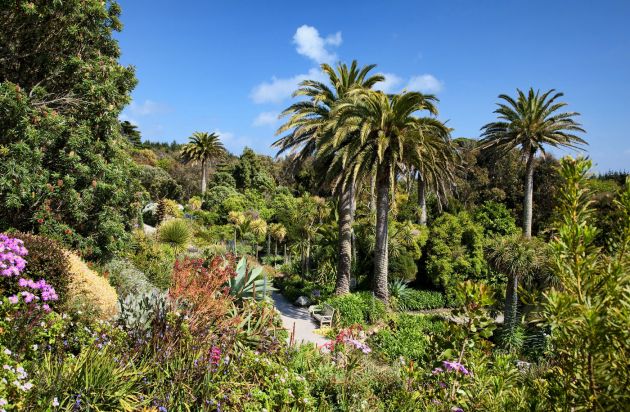Tresco is the second largest of the islands, with an amazing variety of scenery, from the wild and windswept north of the island, to the sub-tropical Abbey Gardens and sandy beaches of the South.
Much of the island's early history (and indeed present) revolved around Tresco Abbey. Built during the reign of Henry I in the 12th century the Benedictine "abbey" was an outpost of Tavistock Abbey, which means it was actually a priory. All that remains of St Nicholas' Priory today are a pair of arches set in a section of wall. From these ruins you get the impression that this was an important building for the Scillies.
In those days the relatively unprotected Scillies were seen as easy pickings by pirates and the Vikings. There is evidence of numerous raids and this is the most likely reason for the priory's decline and eventual disuse, as opposed to the Dissolution of the Monasteries which came some time later.
In the Middle Ages the waters between Tresco and Bryher were the preferred anchorage for ships visiting the islands because of the shelter offered by the higher ground to either side. There was also safe harbour on the other side of Tresco at Old Grimsby Sound. During Tudor times, as England fell out with its Catholic neighbours, the possibility of the islands falling into enemy hands prompted the construction of a number of coastal defences on Tresco. The first of these were King Charles’s Castle overlooking New Grimsby and the Blockhouse overlooking Old Grimsby, both built in the 1550s.
Almost a hundred years later, and after the suppression of a Royalist rebellion on the islands, a new castle was built to protect the waters off New Grimsby. King Charles' Castle was badly sited and the cannons could not provide sufficient cover from the high position. The replacement fort known as Cromwell's Castle was set just above sea level and consists of a 60 feet (20m) tall round tower. Just across the water from the tower is Hangman's Island. There are two suggestions as to where this name came from; one is that it is where Admiral Blake set up his gallows to deal with the Royalist rebels, the other is that it is derived from the Cornish for rock - an maen.
A wealthy merchant banker, Augustus Smith purchased the Isles from the Duchy of Cornwall in the 1830’s. The other islands have since been ceded back to the Duchy, but Tresco remains in the ownership of the family, with the present owners being Robert and Lucy Dorrien-Smith. Augustus Smith was a plant collector and botanist, who recognised the climatic advantages of the islands, and began the creation of Tresco Abbey Garden.
The garden contains sub-tropical and temperate climate plants from around the world. It is said that many of the plants were bought from passing ships returning from more exotic climes. The collection features plants which will not grow outdoors anywhere else in the UK owing to the mild Scillonian winters.
The opposite end of Tresco is quite a contrast to the lush vegetation of the gardens and long crescents of white sand. The relatively high ground here is closer in look and feel to the moorland of west Cornwall with its craggy granite outcrops and heather. Set towards the northern tip of Tresco is the intriguing sea cave. Piper's Hole was reputedly the haunt of smugglers and apparently a mermaid. Although you are unlikely to see either of these the cave does go back around 80 metres from its rather underwhelming entrance. Within the cave is a high vaulted chamber containing a freshwater pool which you can wade across. Back in Victorian times the cave was something of an attraction and a small punt was kept to cross the pool and candles to create a magical ambience.
Tresco is a small community of around 150 residents, who work mainly for the tourist industry. In November 1999, Robert Dorrien-Smith purchased Hell Bay on Bryher, to complement the estate on Tresco. The island has a shop, restaurant and gallery and some holiday accommodation.










